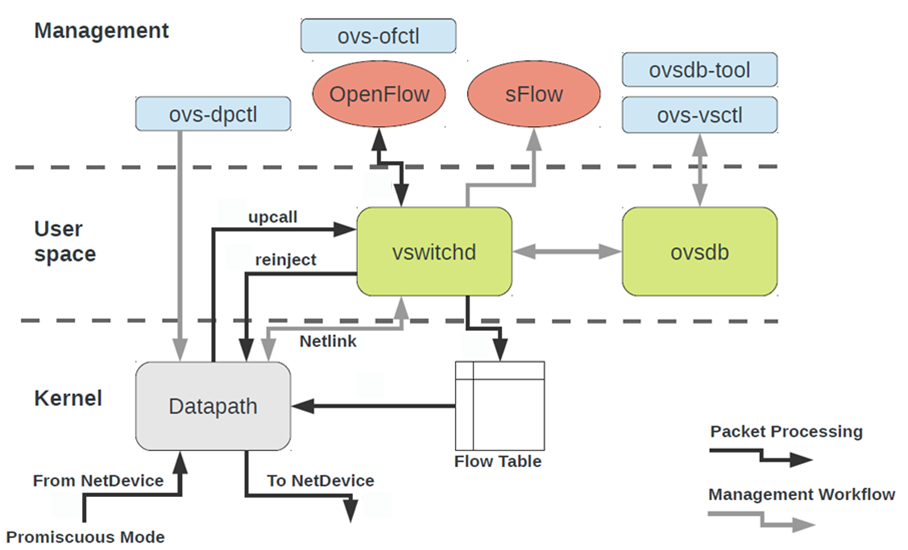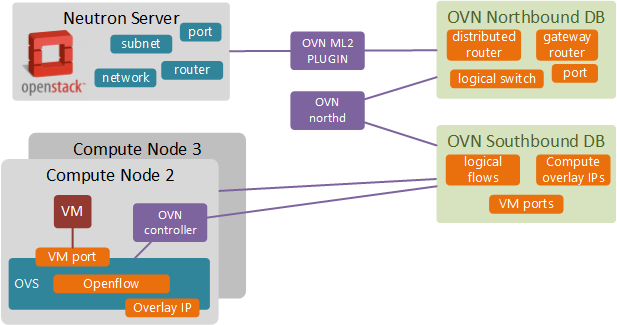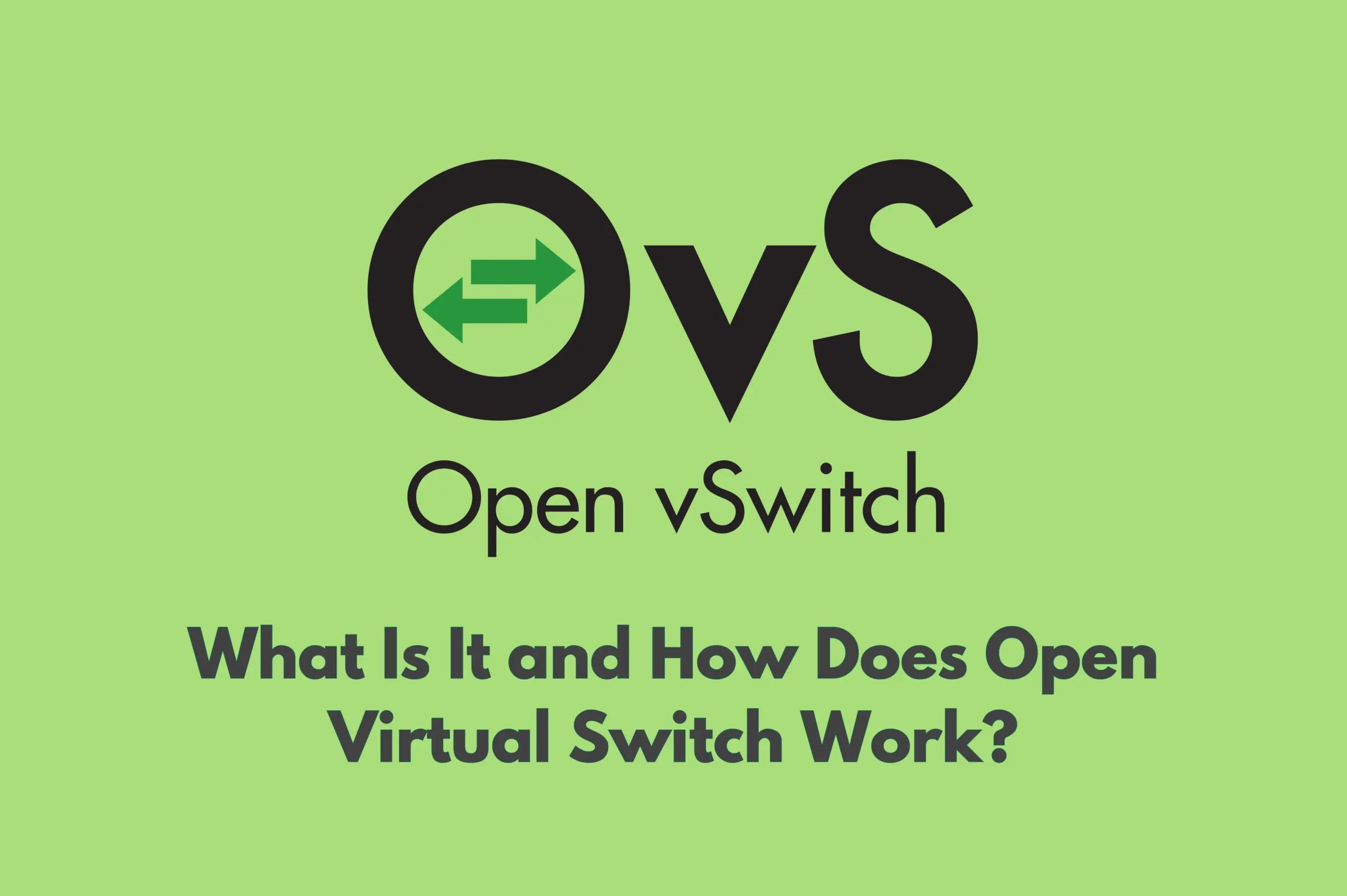Open vSwitch (OVS): What Is It and How Does Open Virtual Switch Work?
Open vSwitch (OVS) has emerged as a cornerstone technology when it comes to datacenters and software-defined networks (SDN). Its ability to seamlessly integrate with virtualization platforms, deliver high performance, and enable advanced network automation has made it a crucial piece of modern infrastructure.
Let’s take a look at the features, benefits, architecture, and diverse applications of OVS, that make it the go-to choice for datacenter and SDN deployments.
OVS definition: What is Open vSwitch?
Open vSwitch (OVS) is an open source, multilayer and OpenFlow capable virtual switch licensed under the open source Apache 2 license. It is designed to provide production-grade switching functionality while enabling massive network automation with programmatic control.
OVS supports standard management interfaces and protocols, making it a great fit for virtualization environments, cloud platforms, and it plays a crucial role in modern virtualized and software-defined networking (SDN) environments. It is capable of serving as a virtual switch within hypervisor-based systems, interconnecting virtual machines (VMs) on the same host or across different physical servers. Let’s see in more detail the use-cases and features of OVS that make it such an irreplaceable solution in today’s fast-paced tech landscape.
Why is Virtual Switching so important in the Data Center world?
Once upon a time, servers in data centers had to be physically connected to hardware switches. But virtualization flipped that script. When VMware introduced server virtualization, the network access layer was redefined thanks to the virtual switch. Instead of relying on physical connections, virtual switches like OVS let virtual machines (VMs) and containers connect to a software layer running right inside the server.
This means that with the arrival of virtual switches, VMs and containers now have their own virtual Ethernet ports, plugging directly into a virtual switch and OVS is one of the top players in this space, alongside VMware’s virtual switches and Cisco Nexus 1000V.
OVS was built to fill the gap for Linux-based hypervisors like KVM and XEN and it has since become the go-to choice for open-source projects like OpenStack.
This shift to virtual switching revolutionized the access layer offering great advantages such as dynamic scaling, overlay network support, multi-tenancy, and centralized control. They will not only adapt to your workloads but also ensure traffic isolation for tenants, and work with SDN controllers for automated management.

Features
Besides the above mentioned advantages, OVS Switch has a vast array of features to tackle everything from simple setups to complex, multi-tenant data centers:
- Its Hypervisor Integration allows OVS to work seamlessly with KVM, VirtualBox, Xen/XenServer, and other Linux-based virtualisation technologies.
- The Layer 2 and Layer 3 offers you support From VLAN tagging to advanced routing.
- OpenFlow Protocol Support allows OVS to easily plug into SDN solutions.
- It has Multiple Tunneling Protocols that support VXLAN, GRE, Geneve, and more for network encapsulation.
- QoS fine-grained control and Traffic Policing ensure your critical apps get priority.
- Visibility Tools such as NetFlow, sFlow, and port mirroring make sure that you always know what’s happening in your network.
- High-Speed Performance thanks to a Linux kernel module that delivers lightning-fast packet processing, while the userspace option offers portability.
Benefits of Open vSwitch
There are several reasons why so many data centers and SDN setups rely on OVS, let’s take a look at a few:
- Scalability: Handles large-scale deployments effortlessly.
- Flexibility: Open architecture means it adapts to any use case, from private clouds to edge computing.
- Automation: Simplifies management with OpenFlow and SDN controllers.
- Cost Savings: Open-source and hardware-agnostic—what’s not to love?
- Enhanced Monitoring: Deep insights make troubleshooting and optimization a breeze.
Architecture
Of course all of the above wouldn’t be possible without a solid architecture. Here is a short list of what’s under the hood:

- ovs-vswitchd: The brains behind switch operations.
- ovsdb-server: A transactional database for managing configurations.
- Kernel Module: For high-speed packet forwarding.
- Userspace Datapath: A portable option, great for DPDK and non-Linux setups.
- OpenFlow Support: Enables centralized network control with SDN controllers.
Where is Open vSwitch used?
Open vSwitch has become indispensable across a wide range of networking scenarios. From datacenters to the edge, OVS can be used everywhere, here are a few examples.
In Datacenter Networking, OVS connects VMs across physical servers, forming the backbone of virtualized environments.
Open Virtual Switch also plays a central role in Software-Defined Networking where it works with controllers like OpenDaylight to provide centralized control and automation.
It’s also a key player in Cloud Platforms like OpenStack Neutron, making sure that integration and management of virtualized networks run seamlessly.
Beyond the datacenter, OVS extends its versatility to Edge Computing, where it supports IoT and real-time applications in distributed networks. It has robust Traffic Monitoring capabilities that are powered by tools such as sFlow and NetFlow, which provide critical insights on network performance. OVS also facilitates Service Chaining, directing traffic between network functions to create complex, efficient workflows.
While OVS is a mature solution for SDN networking, its development was initially driven to introduce competition to proprietary virtual switches and provide an open source alternative. With its first release in 2009, it quickly became popular due to its support of a variety of popular protocols and even became the default virtual switch solution for Openstack back in 2012. However, it came with a lack of a central control plane and high-level API. In response to growing popularity and demand for OVS as part of the same project development of Open Virtual Network (OVN) was started in 2013. It helped to overcome the challenges of scaling and easier integration with other systems. While still using OVS as a lower-level workhorse (dataplane) and keeping its features (OpenFlow, DPDK) Open Virtual Network (OVN) has introduced higher-level abstractions (dataplane) to interact with it. This opened new integration possibilities as popular network abstractions (virtual switches, ports, tunnels) could now be configured declaratively via OVN instead of manual configuration through OVS CLI.
Being first released in 2015 OVN has been a mature solution for years. Today both OVS and OVN are viable solutions for network automation and are widely used by virtualization and containerization platforms such as Openstack, Proxmox and Kubernetes. At Cloudification we use OVS and OVN as a part of c12n to offer seamless multi-tenant networking inside of OpenStack as demonstrated on the diagram below. An OVS running on each compute node is being controlled by OVN and OVN gets configured through OpenStack Neutron – network API component.

Together, OVS and OVN create a scalable and automated software-defined networking solution that fits well for modern datacenter demands. OVN abstracts the complexity of OVS, making configuration more user-friendly while ensuring efficient and highly scalable virtual networking.
Closing Thoughts
Open vSwitch isn’t just a virtual switch, it’s a revolution in how networks are built and managed. Whether you’re scaling a datacenter, diving into SDN, or exploring the edge, OVS delivers the performance, flexibility, and features you need to stay ahead. It’s open-source, future-proof, and ready to power the next generation of networking. So, what are you waiting for? Contact us if you are ready to dive in and see how OVS can transform your infrastructure!

